Are you ready to embark on an exciting journey of growing your own basic herbs for a thriving kitchen garden? Growing herbs in your kitchen garden is not only a rewarding experience but also a delicious way to enhance the flavors of your dishes. Whether you have a large backyard or a small balcony, you can easily grow an assortment of herbs that will add freshness and vibrancy to your culinary creations.
Imagine being able to step outside and pluck a handful of fresh basil, parsley, or mint to garnish your salads or infuse your sauces with aromatic flavors. With a little effort and care, you can cultivate your very own kitchen garden filled with a variety of essential herbs.
Key Takeaways:
- Growing your own basic herbs for a kitchen garden is a rewarding and delicious experience.
- Some essential herbs to grow include parsley, mint, basil, sage, rosemary, thyme, cilantro/coriander, and more.
- These herbs are easy to grow and require minimal care.
- You can harvest fresh herbs as needed to bring vibrant flavors to your cooking.
- Whether you have a small balcony or a large backyard, you can create your own thriving kitchen garden.
Why Grow Your Own Kitchen Garden Herbs?
There are numerous reasons why growing your own kitchen garden herbs can be a rewarding and enjoyable experience. Not only do they add fresh flavors to your dishes, but they also provide a sense of accomplishment and connection to nature. Plus, it’s incredibly convenient to have a ready supply of herbs right at your fingertips when you’re in the middle of cooking.
When it comes to choosing which herbs to grow, it’s best to start with the easy-to-grow varieties that are commonly used in everyday cooking. Some of the most common herbs for a kitchen garden include parsley, mint, basil, sage, rosemary, thyme, cilantro/coriander, fennel, chamomile, tarragon, lavender, chives, arugula, bay leaves, lemon verbena, chervil, and oregano. These herbs are not only versatile in their culinary uses but also resilient and forgiving, making them perfect for beginners or those with limited gardening experience.
Growing your own kitchen garden herbs allows you to have complete control over the growing process. You can choose to grow them organically, free from harmful pesticides and chemicals, ensuring that you’re getting the freshest and healthiest herbs possible. It also gives you the opportunity to experiment with different varieties and flavors that may not be readily available in stores.
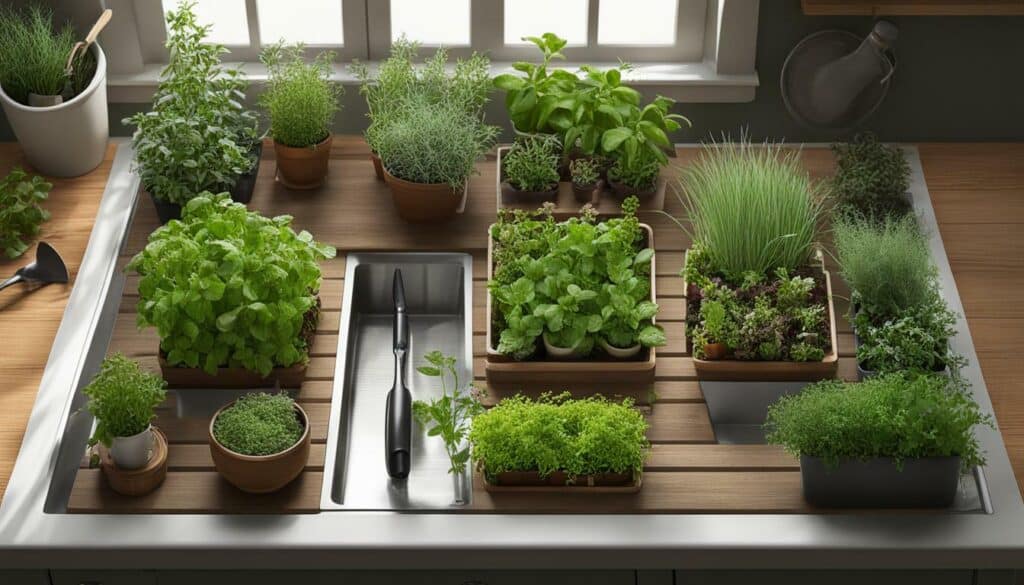
| Herb | Difficulty Level | Growing Tips |
|---|---|---|
| Parsley | Easy | Requires well-drained soil and regular watering. |
| Mint | Easy | Thrives in moist soil and partial shade. |
| Basil | Easy | Needs warm temperatures and plenty of sunlight. |
| Thyme | Easy | Tolerates drought and prefers well-drained soil. |
Whether you have a large garden or just a small balcony, growing your own kitchen garden herbs is a fulfilling and accessible way to enhance your culinary creations. With minimal care and the right growing conditions, you’ll be able to enjoy the fresh flavors and aromas of these herbs all year round.
Essential Herbs for Kitchen Garden Beginners
If you’re new to kitchen gardening, these essential herbs are a great starting point to kickstart your green thumb journey. Not only are they easy to grow, but they also offer a range of flavors that can elevate your culinary creations. With minimal care required, these beginner herbs are perfect for those just diving into the world of growing their own kitchen garden.
One of the most versatile herbs to grow is parsley. Whether it’s the curly leaf or flat-leaf variety, parsley adds a fresh and vibrant taste to your dishes. It pairs well with a variety of flavors and is a staple in many cuisines. Another must-have herb is mint, known for its refreshing flavor and aromatic qualities. It’s the perfect addition to summer salads, refreshing drinks, and even desserts.
“Growing your own kitchen garden herbs not only provides you with fresh ingredients, but it also allows you to savor the flavors that store-bought herbs can’t match,” says gardening expert Anna Green.
“There’s something special about stepping outside and plucking a few leaves of basil to add to your pasta sauce or harvesting rosemary for a roasted chicken. It brings a sense of satisfaction and connection to your food.”
| Essential Herbs for Kitchen Garden Beginners | Culinary Uses | Growing Tips |
|---|---|---|
| Parsley | Salads, soups, sauces, garnish | Plant in well-draining soil, water regularly, and provide partial shade |
| Mint | Cocktails, teas, salads, desserts | Plant in a container to control its spreading, keep well-watered, and provide partial shade |
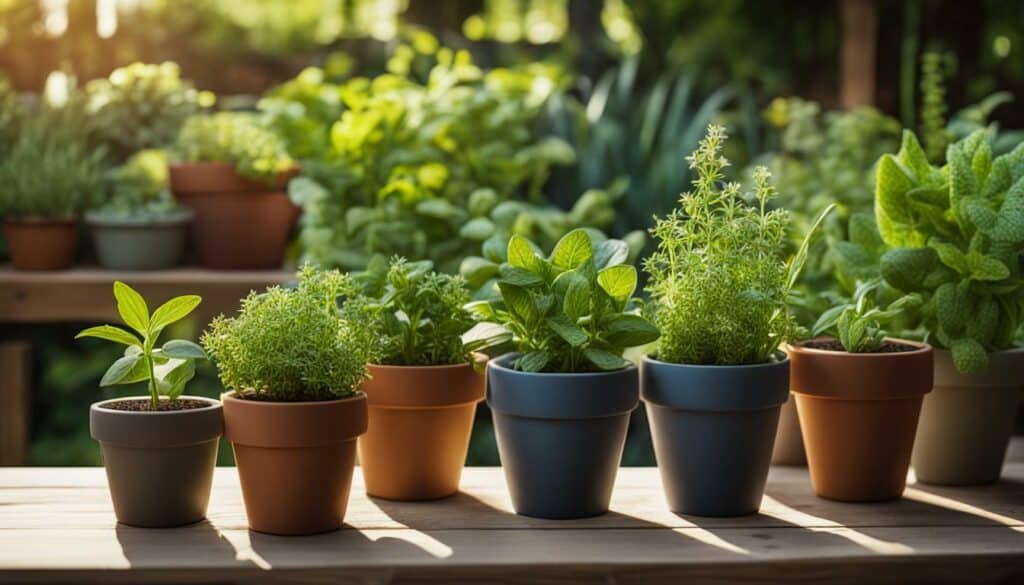
As you embark on your kitchen garden journey, these essential herbs will ensure a successful and fulfilling experience. From parsley and mint to a variety of other flavorful options, you’ll be able to enjoy the taste of freshly grown herbs in your cooking. Remember to plant them in well-draining soil, provide proper care, and harvest them as needed. Soon, you’ll be impressing your friends and family with dishes infused with the vibrant flavors of your own kitchen garden.
How to Grow Basic Herbs in Your Kitchen Garden
Growing basic herbs in your kitchen garden is easier than you may think. Here are some helpful guidelines to ensure your herbs thrive:
- Choose a sunny spot: Most herbs thrive in full sun, so make sure to pick a location in your garden that receives at least 6 hours of direct sunlight each day. This will help your herbs grow strong and flavorful.
- Prepare the soil: Herbs prefer well-draining soil with a pH level of 6 to 7. Amend the soil with organic matter like compost or aged manure to improve its texture and fertility. This will provide a nutrient-rich environment for your herbs to grow.
- Start from seeds or seedlings: Depending on the herb, you can start from seeds or purchase young plants from a nursery. Follow the recommended planting instructions and spacing requirements for each herb to ensure proper growth.
- Water regularly: Herbs require regular watering to keep the soil moist but not overly wet. Water deeply and allow the top inch of soil to dry out between waterings. Avoid overwatering as it can lead to root rot and other issues.
- Control pests naturally: To protect your herbs from pests, use organic pest control methods such as companion planting, neem oil sprays, or introducing beneficial insects like ladybugs and lacewings. This will help maintain a healthy environment for your herbs.
Remember, each herb has its own specific requirements, so it’s important to research and understand the needs of the herbs you’re growing.
Table 1: Basic Herbs for Your Kitchen Garden
| Herb | Growing Tips | Culinary Uses |
|---|---|---|
| Parsley | Plant in well-draining soil. Harvest outer leaves first. | Adds freshness to salads, soups, and sauces. |
| Mint | Requires ample moisture and partial shade. Divide plants regularly to control spreading. | Perfect for refreshing beverages, desserts, and savory dishes. |
| Basil | Plant in warm soil after the danger of frost has passed. Pinch off flowers to encourage leaf growth. | Enhances the flavor of Italian and Mediterranean dishes. |
By following these guidelines and nurturing your herbs with care, you’ll soon be enjoying the bountiful flavors of your very own kitchen garden.
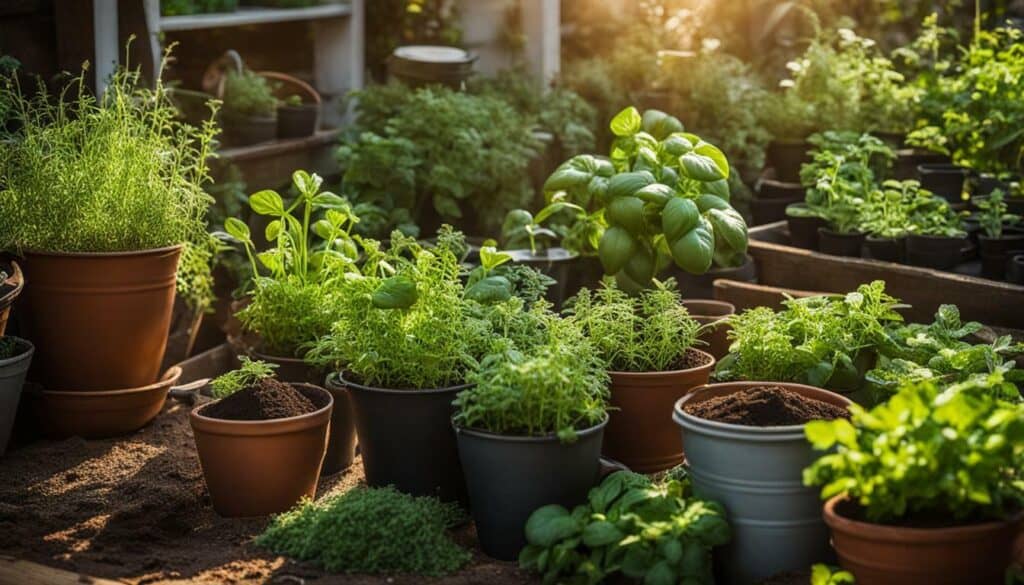
Parsley and Mint: Must-Have Kitchen Garden Herbs
Parsley and mint are two indispensable herbs that every kitchen gardener should consider growing. Not only do they add a burst of fresh flavor to a variety of dishes, but they are also incredibly easy to grow and require minimal care.
Parsley, with its vibrant green leaves and mild, slightly peppery taste, is a versatile herb that can be used as a garnish, in salads, and in a wide array of savory dishes. It is rich in vitamins A, C, and K, and also contains antioxidants that promote overall health.
Mint, on the other hand, is known for its refreshing and cooling properties. Its aromatic leaves can be used in teas, cocktails, desserts, and as a garnish for savory dishes. Mint is also a natural insect repellent and can be grown alongside other plants to help ward off pests.

The Versatility of Parsley
Parsley comes in two main varieties: curly leaf and flat-leaf (also known as Italian parsley). While both can be used in cooking, flat-leaf parsley is favored by many chefs for its stronger flavor. Whether you’re adding it to soups, stews, marinades, or sauces, parsley brings a bright and fresh element to your dishes.
Refreshing Mint Delights
Mint comes in various types, including spearmint and peppermint, each with its own unique flavor profile. Spearmint is milder and sweeter, making it perfect for adding a refreshing twist to beverages, desserts, and even savory dishes like lamb or tabbouleh. Peppermint, with its stronger flavor, is commonly used in candies, chocolates, and breath fresheners.
| Herb | Flavor | Uses |
|---|---|---|
| Parsley | Mild, slightly peppery | Garnish, salads, savory dishes |
| Mint | Refreshing, cooling | Teas, desserts, cocktails, garnish |
| Flat-leaf Parsley | Stronger flavor | Soups, stews, marinades, sauces |
| Spearmint | Milder, sweeter | Beverages, desserts, savory dishes |
| Peppermint | Strong flavor | Candies, chocolates, breath fresheners |
“Growing parsley and mint in your kitchen garden is not only rewarding but also a great way to elevate the flavors of your dishes. Freshly picked herbs add a vibrant touch that simply can’t be replicated with dried herbs. Plus, you’ll have the satisfaction of knowing exactly where your ingredients come from and that they are free from pesticides and other chemicals.”
So why not start your own kitchen garden and enjoy the pleasure of plucking fresh herbs like parsley and mint whenever your culinary creations call for a burst of flavor? Whether you have a spacious backyard or just a windowsill, these versatile herbs can thrive in containers or in garden beds. With their delightful flavors and ease of care, parsley and mint are the perfect additions to any kitchen garden.
Exploring the Aromatic Trio: Basil, Sage, and Rosemary
Take your kitchen garden to the next level with the aromatic trio of basil, sage, and rosemary. These three herbs not only add delightful flavors to your dishes but also bring a touch of elegance and sophistication to your culinary creations. Let’s dive into the world of these kitchen garden essentials and discover their unique qualities.
Basil, with its vibrant green leaves and sweet, slightly peppery taste, is a staple in many cuisines. Whether you’re making a classic Caprese salad, homemade pesto, or a refreshing summer cocktail, basil adds a fresh and aromatic twist to any recipe. It’s incredibly versatile and can be grown in containers or in the garden, making it accessible to all types of home gardeners.
Sage, with its soft, velvety leaves and earthy flavor, is perfect for enhancing savory dishes. From roasted meats to hearty stews, sage adds depth and warmth to your cooking. It’s also well-known for its medicinal properties and is often used in natural remedies for its soothing effects. Growing sage in your kitchen garden ensures a steady supply of this versatile herb for all your culinary and wellness needs.
Rosemary, with its fragrant needle-like leaves and piney aroma, is a must-have herb for any kitchen garden. It pairs beautifully with meats, roasted vegetables, and even baked goods. Rosemary is known for its resilience and can thrive in various growing conditions. Its woody stems and robust flavor make it an essential component of any herb garden.
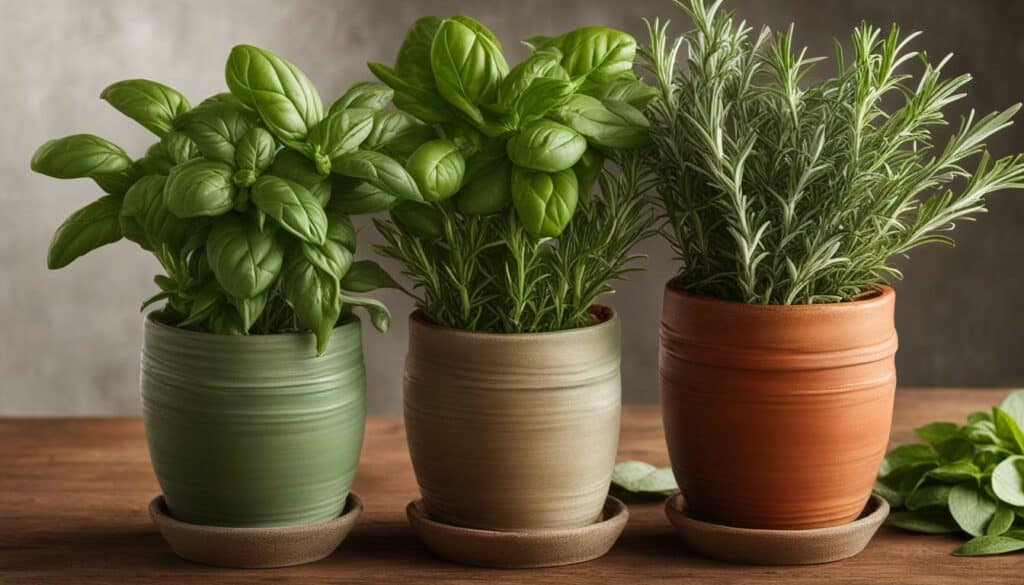
| Herb | Flavor | Growing Conditions |
|---|---|---|
| Basil | Sweet, slightly peppery | Full sun, well-drained soil |
| Sage | Earthy, savory | Full sun, well-drained soil |
| Rosemary | Piney, aromatic | Full sun, well-drained soil |
“Basil, sage, and rosemary are like magic ingredients that elevate every dish. Just a hint of their flavors can transform a simple recipe into a culinary masterpiece.” – Chef Emma Johnson
With their distinct flavors and captivating aromas, basil, sage, and rosemary are the perfect additions to any kitchen garden. Whether you’re a seasoned gardener or just starting out, these herbs are easy to grow and require minimal care. So, unleash your inner chef and savor the delights of the aromatic trio in your own culinary creations.
Thyme, Cilantro/Coriander, and Fennel: Flavorful Additions to Your Kitchen Garden
Elevate the flavors of your dishes with the delightful trio of thyme, cilantro/coriander, and fennel from your own kitchen garden. These herbs not only bring a burst of freshness to your recipes but also add a unique depth of flavor that will impress your taste buds.
Thyme is an aromatic herb that is widely used in Mediterranean cuisine. Its earthy and slightly minty flavor pairs well with a variety of dishes, including roasted meats, stews, and soups. Growing thyme in your kitchen garden is a breeze, as it requires little maintenance and thrives in well-draining soil and full sun.
Cilantro, also known as coriander in some regions, is a versatile herb with a distinct citrusy flavor. Its leaves and seeds are commonly used in many international cuisines, such as Mexican, Thai, and Indian. Cilantro is easy to grow and can be harvested throughout the season. Just be sure to plant it in a sunny spot with well-drained soil to keep it happy.
Fennel is a herb with a unique licorice-like flavor that adds a refreshing twist to your dishes. Both its bulb and fronds can be used in cooking, offering versatility in recipes. Fennel grows best in cool climates and requires ample sunlight. It is a perennial herb that will continue to provide you with its aromatic goodness year after year.
Thyme, Cilantro/Coriander, and Fennel Growing Tips:
- Plant thyme, cilantro/coriander, and fennel in well-drained soil enriched with organic matter.
- Ensure they receive ample sunlight, at least 6-8 hours a day.
- Water regularly, keeping the soil moist but not waterlogged.
- Harvest the leaves as needed, pinching or cutting off what you require.
- Store excess herbs by drying them or freezing them in ice cube trays with olive oil.
With these flavorful additions in your kitchen garden, you’ll have a constant supply of thyme, cilantro/coriander, and fennel at your fingertips. Their aromatic qualities and unique tastes will inspire you to experiment with a variety of cuisines and create memorable culinary experiences. So why wait? Start growing these kitchen garden herbs today and savor the incredible flavors they bring to your dishes.
| Herb | Flavor Profile | Growth Requirements |
|---|---|---|
| Thyme | Earthy, minty | Well-draining soil, full sun |
| Cilantro/Coriander | Citrusy | Sunny spot, well-drained soil |
| Fennel | Licorice-like | Cool climates, ample sunlight |
“Fresh herbs are the secret ingredients that elevate a dish from good to exceptional. Growing thyme, cilantro/coriander, and fennel in your kitchen garden allows you to enjoy their vibrant flavors whenever you want. So get your hands dirty, nurture these herbs, and let their aromatic essence enhance your cooking.”
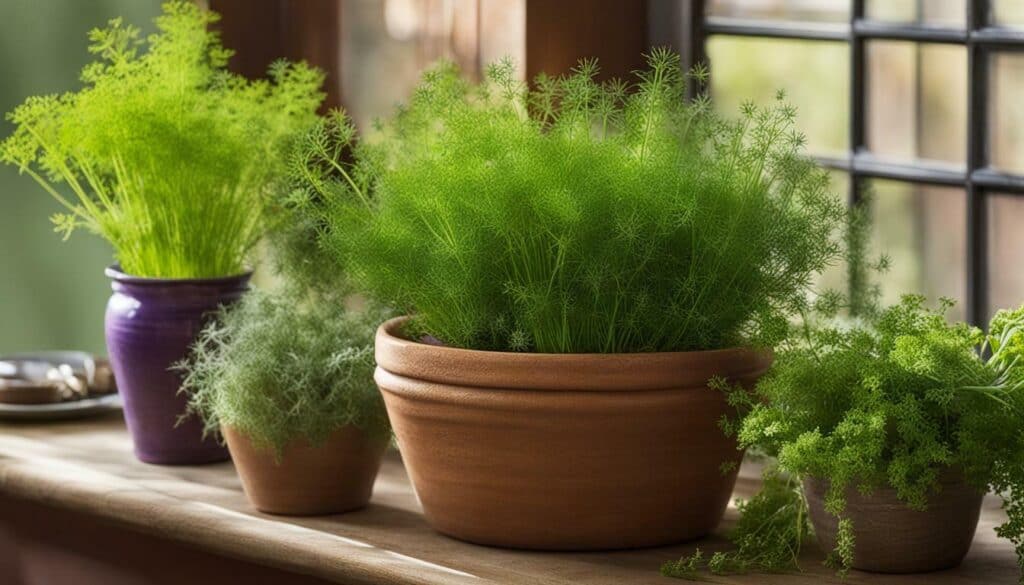
Chamomile, Tarragon, and Lavender: Calming and Fragrant Herbs
Create a serene ambiance and embrace relaxation with the calming trio of chamomile, tarragon, and lavender in your kitchen garden. These aromatic herbs not only add a delightful fragrance to your home, but they also offer numerous health benefits and culinary possibilities.
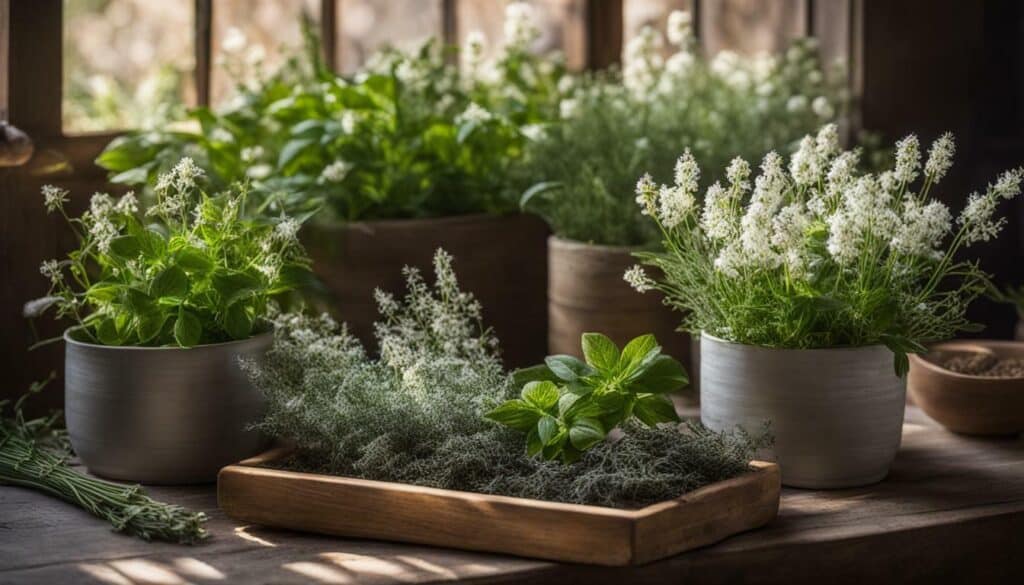
Chamomile, known for its soothing properties, is often used as a natural remedy for restlessness and stress. It can be enjoyed as a delicious herbal tea or incorporated into various dishes, adding a subtle floral flavor.
| Herb | Growing Tips | Culinary Uses |
|---|---|---|
| Chamomile | Plant in well-drained soil and ensure ample sunlight. Harvest the flowers when fully bloomed and dry them for later use. | Infuse the flowers in hot water to make a soothing tea. Add fresh or dried chamomile flowers to salads, soups, or desserts for a delicate flavor. |
| Tarragon | Plant in rich, well-drained soil with partial shade. Regularly prune to maintain its growth and flavor. | Enhance the taste of your sauces, dressings, and marinades with the subtle licorice flavor of tarragon. It pairs well with poultry, seafood, and vegetables. |
| Lavender | Plant in well-drained soil and provide full sun exposure. Prune after flowering to promote bushier growth. | Add a touch of elegance to your culinary creations with lavender. Use the fragrant flowers to infuse sugar, oils, and vinegars, or incorporate them into baked goods for a unique twist. |
These versatile herbs are easy to grow and thrive in both containers and garden beds. They require minimal care and can be harvested as needed, allowing you to enjoy their fresh flavors at any time. Whether you’re brewing a soothing cup of chamomile tea, adding a hint of tarragon to your sauces, or infusing your recipes with the delicate essence of lavender, these herbs are sure to elevate your culinary experience.
Chives, Arugula, and Bay Leaves: Versatile and Flavorful Kitchen Garden Favorites
Add a touch of versatility and robust flavor to your kitchen garden with the beloved trio of chives, arugula, and bay leaves. These herbs not only add a fresh burst of aroma to your dishes but also provide an array of culinary possibilities.
Chives, with their delicate onion-like taste, are a must-have herb for any kitchen garden. They are incredibly versatile and can be used as a garnish, in salads, soups, and even creamy sauces. With their bright green color and slender stems, chives also make a visually appealing addition to your garden.
Arugula, also known as rocket, adds a peppery kick to your culinary creations. This leafy green herb is perfect for salads and sandwiches, adding a tangy bite that takes your dish to the next level. It’s quick and easy to grow, making it an ideal choice for beginner gardeners.
Bay leaves, on the other hand, bring a distinctive depth of flavor to your cooking. Whether you’re simmering a hearty stew or infusing flavor into a marinade, bay leaves are an essential ingredient. They can be dried and stored for future use, ensuring you always have a fragrant supply on hand.
| Herb | Culinary Uses | Growing Tips |
|---|---|---|
| Chives | Garnish, salads, soups, sauces | Plant in well-drained soil, water regularly |
| Arugula | Salads, sandwiches | Plant in fertile soil, keep moist |
| Bay Leaves | Stews, marinades | Plant in large containers or the ground, provide adequate sunlight |

“Chives, arugula, and bay leaves add a burst of freshness and flavor to my dishes. Whether I’m sprinkling chives on top of a creamy potato soup or adding a handful of arugula to my favorite pasta salad, these herbs elevate the taste to a whole new level. And when it comes to bay leaves, their distinct aroma and taste infuse my stews with a deep, comforting richness. Growing these herbs in my kitchen garden has been a game-changer for my cooking!” – Mary, avid home cook.
Lemon Verbena, Chervil, and Oregano: Zesty and Zingy Herbs for Your Kitchen Garden
Delight your taste buds with the zesty and zingy trio of lemon verbena, chervil, and oregano from your flourishing kitchen garden. These three herbs not only add a burst of flavor to your dishes but also bring a touch of elegance to your culinary creations.
Lemon verbena, with its vibrant lemony aroma, is the perfect addition to teas, cocktails, and desserts. It pairs well with fruits, adding a refreshing twist to your summer recipes. This versatile herb is also known for its calming properties, making it an excellent choice for herbal infusions and relaxing beverages.
Chervil, often referred to as the “gourmet’s parsley,” offers a delicate anise-like flavor that elevates any dish. Its delicate leaves are best used fresh, adding a mild licorice note to salads, soups, and seafood dishes. Chervil is a staple in French cuisine and is commonly used in classic dishes like fines herbes omelets and sauces.
| Herb | Growing Conditions | Culinary Uses |
|---|---|---|
| Lemon Verbena | Full sun, well-drained soil | Teas, cocktails, desserts, herbal infusions |
| Chervil | Partial shade, rich soil | Salads, soups, seafood dishes, fines herbes omelets, sauces |
| Oregano | Full sun, well-drained soil | Pizzas, pasta sauces, marinades, roasted vegetables |
Oregano, a staple in Mediterranean cuisine, adds a robust and earthy flavor to your favorite dishes. Whether sprinkled on pizzas, stirred into pasta sauces, or used in marinades for grilled meats, oregano enhances the flavors of your recipes. It also pairs well with roasted vegetables, infusing them with a delightful aroma and taste.
Growing lemon verbena, chervil, and oregano is relatively easy, making them ideal choices for both experienced gardeners and beginners. They thrive in sunny locations with well-drained soil and require minimal care. Regular harvesting encourages fresh growth and ensures a continuous supply of these flavorful herbs for your kitchen.
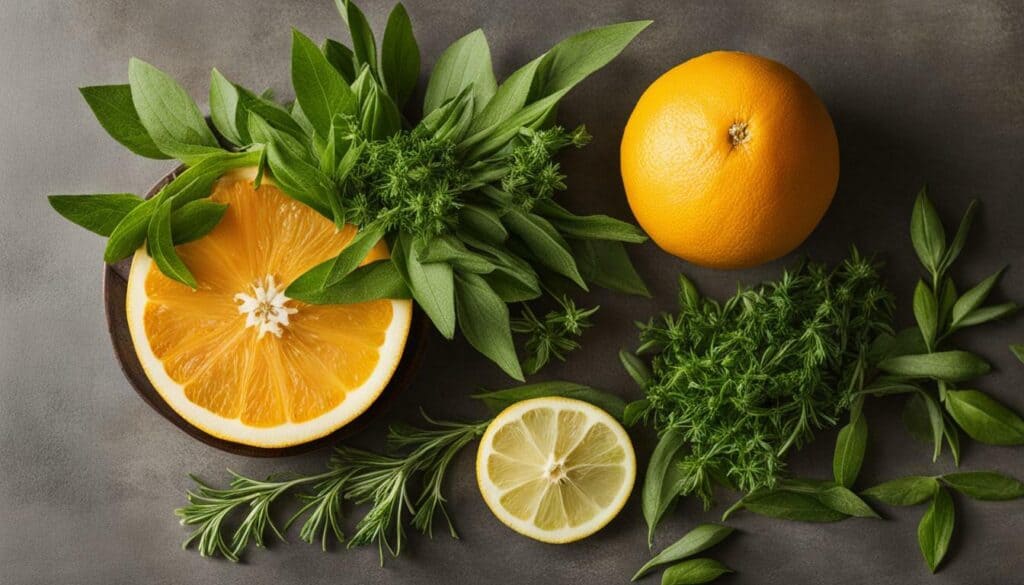
Satisfy your culinary curiosity by adding these zesty and zingy herbs to your kitchen garden. With their vibrant flavors and versatile uses, lemon verbena, chervil, and oregano will elevate your cooking to new heights, allowing you to savor the essence of your own flourishing garden.
In Conclusion: Savor the Flavors of Your Own Kitchen Garden Herbs.
Congratulations on taking the first step towards growing your own kitchen garden herbs! Embrace the journey and indulge in the endless flavors that await you.
By growing your own herbs, you not only have a fresh supply of aromatic and flavorful ingredients right at your fingertips, but you also have the opportunity to add a personal touch to your culinary creations. Whether you have a spacious backyard or a small balcony, herbs can be easily grown in containers or directly in your garden.
Imagine plucking fresh sprigs of parsley, mint, basil, or rosemary to elevate the taste of your salads, soups, or homemade pasta sauces. Thyme, cilantro, and fennel can add a burst of unique flavors to your dishes, while chamomile, tarragon, and lavender offer a calming and fragrant touch. With chives, arugula, and bay leaves, you can experiment with their versatile notes in various recipes.
Let’s not forget the zingy zest of lemon verbena, chervil, and oregano, which can liven up your cocktails, teas, and desserts. The possibilities are endless, and as you nurture your kitchen garden, you’ll discover an abundance of ways to incorporate these herbs into your daily life.
So, roll up your sleeves, get your hands dirty, and watch as your herbs flourish under your care. They require minimal maintenance and can be harvested as needed, ensuring that your dishes are infused with the freshest and vibrant flavors. Happy growing and savoring the delights of your very own kitchen garden!
Are the Basics of Growing Vegetables the Same as Growing Herbs for a Kitchen Garden?
Growing vegetables and herbs in a kitchen garden requires a similar understanding of basic gardening principles. However, the methods to grow vegetables properly may differ slightly from growing herbs. While both require appropriate sunlight, watering, and soil conditions, vegetables often need more space and frequent maintenance, whereas herbs can thrive in smaller spaces and require less attention. Ultimately, tailoring your approach to each plant’s specific needs will ensure successful growth in your kitchen garden.
FAQ
Q: Can I grow herbs in my kitchen garden?
A: Absolutely! Growing herbs in your kitchen garden is a great way to enhance the flavor of your dishes. You can grow them in containers or in the garden, and they require minimal care.
Q: What are some essential herbs to grow in a kitchen garden?
A: Some essential herbs to grow include parsley, mint, dill, basil, sage, rosemary, thyme, cilantro/coriander, fennel, chamomile, tarragon, lavender, chives, arugula, bay leaves, lemon verbena, chervil, and oregano.
Q: Are these herbs easy to grow?
A: Yes, these herbs are easy to grow and perfect for beginners. They require minimal care and can be harvested as needed for fresh flavor in your cooking.
Q: Can I grow herbs in containers?
A: Absolutely! Herbs can be easily grown in containers, making them ideal for small spaces like balconies or windowsills. Just make sure the containers have good drainage.
Q: How do I harvest herbs from my kitchen garden?
A: To harvest herbs, simply snip off the desired amount with sharp scissors or pruning shears. It’s best to harvest in the morning when the oils in the herbs are most concentrated.
Q: Can I use herbs from my kitchen garden in cooking?
A: Yes, absolutely! These fresh herbs are perfect for adding flavor to your dishes. Just rinse them before use and chop or crush them to release their aromatic oils.
Q: How do I store herbs from my kitchen garden?
A: To store herbs, you can hang them upside down to dry or store them in an airtight container in the refrigerator. You can also freeze herbs in ice cube trays with water or oil for easy use.
Q: How often should I water my kitchen garden herbs?
A: Herbs generally prefer well-drained soil, so make sure not to overwater them. Water them when the top inch of soil feels dry to the touch.
Q: Can I grow kitchen garden herbs indoors?
A: Yes, many herbs can be successfully grown indoors. Just make sure they receive enough sunlight or use artificial lights to provide adequate lighting.
Q: Can I grow kitchen garden herbs all year round?
A: The ability to grow herbs year-round depends on your climate and the specific herb. Some herbs are more cold-hardy and can withstand winter conditions, while others may need to be brought indoors or replanted each season.





Leave a Reply